You'll need a multi-layered approach to protect your data center from electrostatic discharge (ESD) damage. Start by maintaining 50% relative humidity and implementing ESD-safe workstations with proper grounding equipment. Equip your team with anti-static gear like wrist straps and conductive footwear, while installing static-dissipative flooring throughout critical areas. Train all personnel on ESD prevention protocols and maintain strict compliance with ANSI/ESD S20.20 standards. Regular testing and monitoring of grounding systems, combined with proper cleaning procedures using ESD-safe materials, will guarantee thorough protection. These foundational steps open the door to a complete electrostatic defense strategy.
Understanding ESD Risk Factors
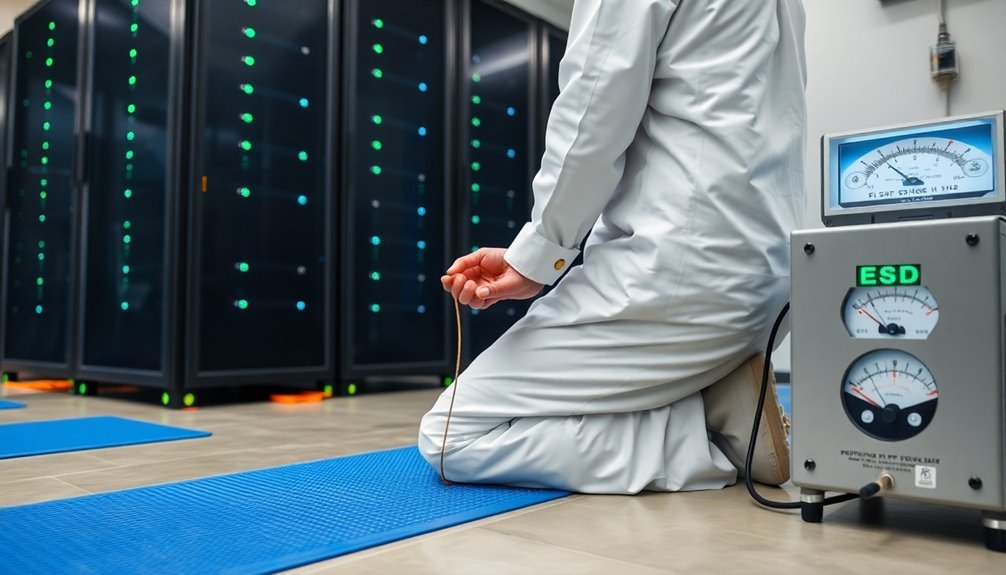
In today's data centers, understanding electrostatic discharge (ESD) risk factors is essential for protecting sensitive electronic equipment.
Static electricity generation occurs primarily through friction and triboelectric charging when objects rub against each other. Common activities like personnel movement around facilities can significantly increase static buildup. This risk increases substantially in low-humidity environments, where static charges accumulate more readily on surfaces.
Your electronic components face considerable vulnerability to ESD damage. The Human-Body Model and Charged-Device Model sensitivity levels indicate that components can be damaged by discharges as low as 1000 volts and 250 volts, respectively. You'll need to take into account these thresholds when handling equipment and designing protection systems.
Environmental conditions play a vital role in ESD risk management. While high humidity can help reduce static buildup, it's not always practical due to increased energy costs and operational expenses. You'll need to balance these factors carefully.
The type of flooring you choose and your grounding systems will markedly impact your facility's ESD risk profile.
You can't overlook the human factor either. Personnel movement and equipment handling increase static generation risks, making proper training and ESD-safe workstations essential components of your defense strategy.
Essential ESD Prevention Equipment
Armed with an understanding of ESD risks, you'll need specific equipment to create a thorough defense system. Start by installing ESD-safe workstations equipped with antistatic wrist straps and grounding mats that safely discharge static electricity.
You'll also need conductive table mats to establish reliable grounding and bonding connections.
For your flooring solutions, implement anti-static options like Dycem mats or Sherwin-Williams resinous flooring that meet ANSI/ESD standards. These materials provide a safe path for static charges to dissipate while offering chemical and impact resistance. Dycem mats are particularly effective at dissipating static charges at 10⁸ ohms.
You'll want to guarantee seamless installation for maximum protection and easy maintenance.
Don't forget to replace common plastic items with their ESD-safe counterparts. This includes trash cans, computer peripherals, and even basic office supplies like pens and sheet protectors.
You'll need to establish dedicated ESD-controlled areas where you'll implement strict protocols and use only ESD-safe materials and equipment. Make sure these zones feature extensive grounding and bonding techniques, starting from the anti-static flooring up through the workstation level.
Regular assessment of your ESD prevention equipment will help maintain a consistently protected environment.
Personnel Training and Safety Standards
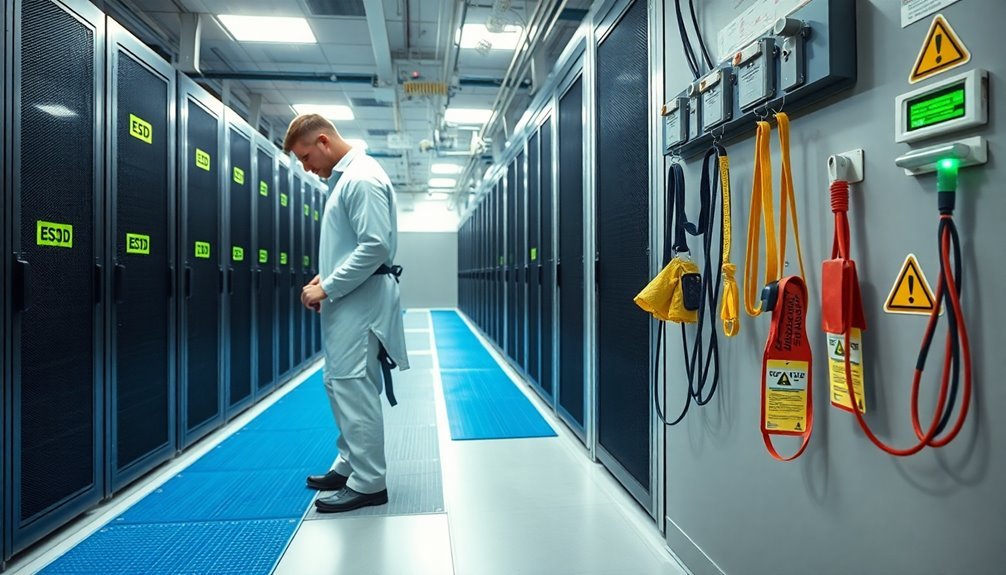
Three critical components form the foundation of effective ESD protection: thorough training, consistent compliance, and regular verification.
You'll need to implement thorough training programs that cover everyone from line employees to executive personnel, including subcontractors and suppliers who handle ESD-sensitive components.
Your training program must address the fundamentals of static electricity, electrostatic discharges, and each person's role in the ESD Control Program plan. Use diverse training tools, including hands-on sessions, computer-based modules, and technical documentation, while maintaining consistent content across all facilities and regions.
To guarantee safety compliance, you'll need to establish designated ESD control areas with proper grounding systems and antistatic equipment. Testing and certification provide material retention validation through comprehensive assessments.
It's crucial to conduct regular risk assessments and maintain strict adherence to standards like ANSI/ESD S20.20 and IEC 61340-5-1. Don't forget to document all training sessions and maintain detailed records for compliance verification.
Regular audits will help you verify the effectiveness of your training programs and identify areas for improvement.
Remember to implement recurring training sessions to reinforce knowledge and maintain high compliance levels throughout your data center operations.
Static-Free Work Areas Setup
You'll need to establish proper grounding equipment layouts within your data center by strategically placing ESD control mats, wrist straps, and ground points at workstations.
The setup must include clearly marked personnel movement control zones that restrict access to sensitive areas and guide staff through approved pathways with appropriate static-dissipative flooring.
Your grounding equipment layout should create an interconnected network of static-safe zones, ensuring that workers remain properly grounded as they move between different areas of the facility. Regular testing of equipment reveals that ESD damage risks can occur with voltages as low as 10 volts.
Essential Grounding Equipment Layout
In accordance with industry standards, proper grounding equipment layout serves as the foundation for creating static-free work areas in data centers. You'll need to start with a master grounding bus bar (MGB) as your central grounding point, connecting it to rack grounding bus bars installed in individual equipment racks. All bus bars should be connected through a uniform conductor spacing pattern to ensure consistent grounding performance.
To guarantee thorough protection, establish a mesh grounding grid that creates a low-impedance path for dissipating excess electrical energy.
Your static control strategy must include specialized flooring systems. Install conductive flooring that reduces electrostatic charge accumulation while providing a safe path for static dissipation. Don't let the conductive flooring make direct electrical contact with racks, as this can interfere with system analysis.
You'll need to ground all server racks, cabinets, PDUs, and cooling systems individually to prevent electrical faults and equipment damage. Install ground rods around your data center's perimeter to establish solid earth connections.
Remember to follow ANSI/TIA-942 standards and manufacturer requirements for grounding specifications. Maintain your grounding systems through regular evaluations to guarantee they're functioning correctly and meeting certification requirements for your data center's rating level.
Personnel Movement Control Zones
Establishing effective personnel movement control zones requires a thorough approach to static-free work areas. You'll need to implement extensive static control measures throughout your designated zones, including ESD mats, conductive flooring, and anti-static paint or tiles. Regular access control verification helps ensure only authorized personnel enter these sensitive static-controlled environments.
| Zone Type | Primary Controls | Secondary Controls |
|---|---|---|
| High Risk | Wrist Straps & ESD Mats | Conductive Flooring |
| Medium Risk | ESD Footwear | Static-Safe Equipment |
| Low Risk | Basic Grounding | Regular Monitoring |
Your personnel must wear appropriate grounding equipment, including wrist straps connected to common ground points via coiled cords. When setting up these zones, you'll want to eliminate non-essential sources of static, replacing standard items with ESD-safe versions of trash cans and computer peripherals.
Ensure your flooring meets specific performance criteria: it shouldn't generate static, must maintain its protective properties regardless of environmental conditions, and should provide verifiable grounding paths. Don't rely on temporary solutions like static-control waxes – instead, install permanent conductive flooring that's compatible with your facility's requirements. Remember to maintain appropriate conductivity levels that won't interfere with operational equipment while still providing adequate ESD protection.
Testing and Monitoring Protocols
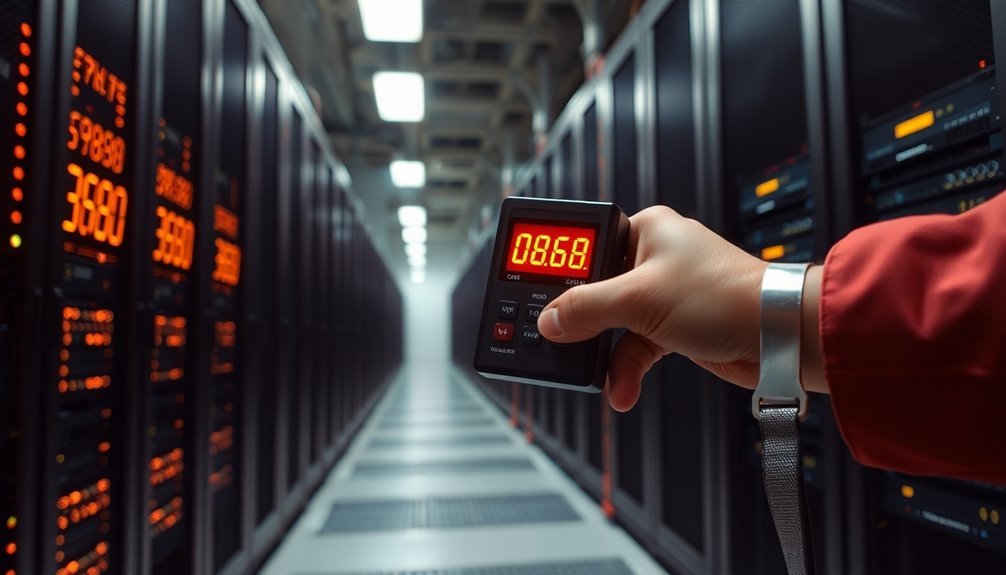
Three primary testing methodologies form the foundation of effective ESD defense protocols in data centers. You'll need to implement contact discharge testing, air discharge testing, and environmental monitoring to guarantee thorough protection.
Contact discharge testing serves as your primary method, following IEC 61000-4-2 standards, while air discharge becomes essential when direct contact isn't possible.
You must conduct testing under controlled conditions, considering that temperature and humidity substantially impact ESD events. Operating at reduced dewpoints can significantly lower energy costs without compromising protection. Your testing equipment should meet IEC 61000-4-2 specifications, using devices like the Teseq NSG 435 or Haefely ONYX16.
When you're conducting tests, pay special attention to the approach speed, as it can affect your results.
You'll need to verify compliance with both Human Body Model (HBM) and Charged Device Model (CDM) standards, following ANSI/ESDA/JEDEC JS-001 and JS-002 respectively. Monitor your equipment's performance against datasheet parameters after each test – any deviation indicates a failure.
Remember that while humidity control helps, you shouldn't rely on it exclusively; ESD flooring and proper footwear provide more reliable protection in your data center environment.
Data Center Cleaning Guidelines
You'll need to follow strict cleaning protocols to maintain a static-free data center environment, starting with ULPA-filtered vacuum systems and anti-static cleaning solutions.
Professional data center cleaning requires trained and supervised crews to ensure proper maintenance standards are met.
Your cleaning equipment must include ESD-safe wipes, specialized mops with non-ammoniated cleaners, and properly grounded tools to prevent charge buildup during maintenance activities.
Regular quarterly cleaning of server cabinets and raised floors, combined with annual deep cleaning of subfloor and ceiling plenums, will help you maintain ideal electrostatic defense throughout your facility.
Essential Cleaning Protocols Checklist
A thorough cleaning protocol forms the backbone of data center maintenance and electrostatic defense. You'll need to follow specific steps when cleaning your facility, starting with proper floor maintenance. Remove floor panels one at a time, and use HEPA-filter vacuums on subfloor areas, being careful around perforated air panels and cables.
For surface cleaning, you'll want to use anti-static solutions and lint-free wipes on work surfaces and equipment. Don't forget to vacuum light fixtures and high ledges, and pay special attention to CRAC water lines and support pipes.
| Area | Equipment Needed | Key Protocol |
|---|---|---|
| Floors | HEPA vacuum, lint-free wipes | Remove panels individually, vacuum subfloor |
| Surfaces | Anti-static solutions, static-dissipative wipes | Clean work areas, avoid liquid near equipment |
| Equipment | HEPA vacuum, anti-static cloths | Focus on exterior hardware, tape libraries |
Remember to maintain strict safety protocols: keep doors closed between equipment and non-equipment rooms, ban food and drinks, and avoid storing cardboard or paper products in equipment areas. You'll want to establish regular cleaning schedules and consistently check for dust accumulation to maintain ideal electrostatic defense.
Advanced Anti-Static Cleaning Equipment
Building upon proper cleaning protocols, selecting the right anti-static cleaning equipment represents a cornerstone of effective data center maintenance. You'll need to equip your cleaning staff with HEPA or ULPA filtered vacuums that capture microscopic particles while preventing interference with sensitive equipment through their shielded motors.
To protect against electrostatic discharge, you must implement a thorough ESD prevention system. This includes anti-static mats, wristbands, and ESD-safe workstations for your cleaning operations.
Don't forget to train your staff on proper grounding and bonding techniques to minimize static risks during maintenance activities.
When selecting cleaning materials, you'll want to use non-abrasive, anti-static cloths and ESD wipes specifically designed for electronic equipment. Your cleaning solutions should be environmentally friendly with low moisture content and free from ammonia to preserve anti-static finishes.
Remember to test these solutions on a small area first and apply them according to manufacturer guidelines.
For conductive flooring maintenance, you'll need specialized equipment including low-speed scrubbing machines and HEPA-filtered vacuums. Confirm your cleaning schedule includes quarterly maintenance of conductive flooring to maintain its anti-static properties and prevent dust accumulation.
Emergency Response for ESD Events
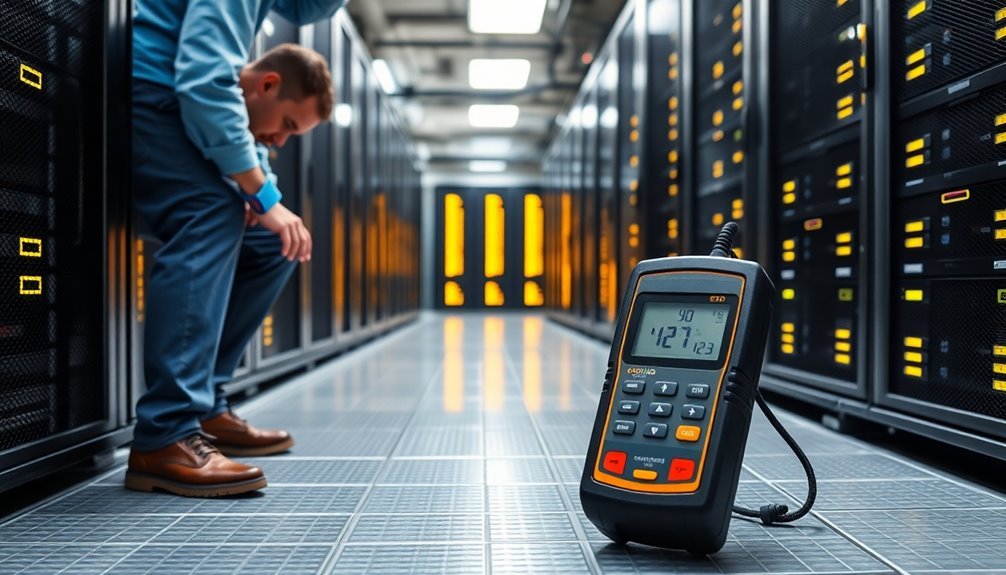
During an electrostatic discharge event, rapid response and proper protocols can mean the difference between minor disruption and catastrophic equipment failure. You'll need to implement continuous monitoring systems and establish clear emergency procedures that align with ANSI/ESD S20.20 standards.
| Emergency Action | Response Time | Critical Equipment |
|---|---|---|
| Static Detection | Immediate | ESD Monitors |
| Area Isolation | < 30 seconds | Grounding Systems |
| Power Control | < 60 seconds | Circuit Breakers |
Your emergency response plan should include proper grounding protocols, immediate area isolation, and rapid deployment of ionizers to neutralize static charges. You'll need to guarantee your staff is thoroughly trained in ESD protection, wearing appropriate footwear and using ESD-protective equipment with resistance to ground of 1.0 x 10^6 to 1.0 x 10^9 ohms.
Install VESDA systems for early fire detection and maintain humidity controls according to ASHRAE recommendations. You should conduct regular audits and assessments to identify potential ESD hazards before they become critical. Remember to properly label all ESD-sensitive components and maintain strict protocols for their handling, including special packaging requirements and controlled environment specifications.
Frequently Asked Questions
How Long Does Anti-Static Flooring Typically Last Before Requiring Replacement?
Your anti-static flooring can last over 20 years if you maintain it properly. You'll need regular cleaning and ohmmeter testing, but factors like maintenance quality, material type, and environmental conditions affect its longevity.
Can Humidity Control Systems Alone Effectively Prevent ESD in Data Centers?
No, you can't rely on humidity control alone to prevent ESD. You'll need thorough ESD protection measures, including ESD flooring and footwear, since humidity control is insufficient by itself to control static charges effectively.
What Temperature Ranges Are Optimal for Minimizing Static Electricity Buildup?
You'll want to maintain temperatures between 59°F and 89.6°F to minimize static electricity. However, with proper ESD protocols like antistatic flooring and footwear, you'll have more flexibility in your temperature settings.
How Often Should ESD Testing Equipment Be Recalibrated for Accuracy?
You'll need to recalibrate your ESD testing equipment every 12 months at minimum, but if you're using it frequently or in critical applications, consider calibrating every 6 months to maintain peak accuracy.
Do Wireless Devices Affect ESD Protection Equipment Performance in Data Centers?
Yes, wireless devices can interfere with ESD protection equipment. You'll need to maintain proper grounding systems and avoid using wireless ESD wrist straps, as they don't meet safety standards or effectively prevent static buildup.
In Summary
You'll find ESD protection is an ongoing commitment requiring vigilance across all aspects of data center operations. By implementing proper protocols, training your staff thoroughly, maintaining static-free environments, and regularly testing your safeguards, you're creating a robust defense against costly electrostatic damage. Don't neglect these proven measures – they're your frontline protection for keeping your sensitive equipment safe and your data center running smoothly.

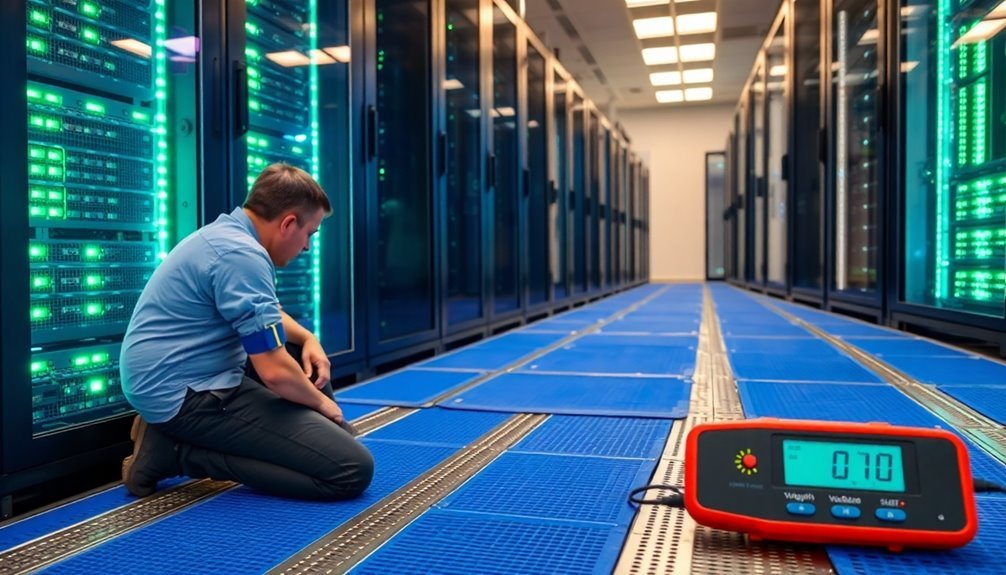



Leave a Reply